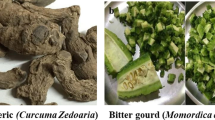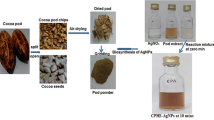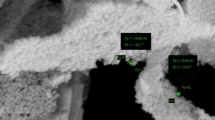Abstract
Access to safe drinking water is among the main challenges in poor countries due to seriously polluted water by waterborne pathogens. Water treatment technology is also prohibitively expensive, and some of it produces harmful by-products. As a result, phyto-fabricated ZnO nanoparticles (ZnO-NPs) are attracting significant interest for their antibacterial activity and potential applications in water disinfection. This study has focused on optimizing the synthesis parameters of ZnO-NPs using coffee husk extract (CHE) as an efficient reducing and capping agent to improve the size and activities, which had not been investigated before at optimal process parameters, such as temperature, zinc precursor-to-CHE ratio, reaction time, and pH. Furthermore, there has not been a study of indigenous CHE total phenolic content. CHE was obtained from coffee husk via ethanol solid-liquid extraction. The total phenolic content of CHE was determined by the Folin-Ciocalteu colorimetric method using gallic acid as a standard. The contribution of CHE in the formation of ZnO-NPs was first observed by a color change to yellowish-white, which was then confirmed using UV-visible spectrophotometry. The synthesis of ZnO-NPs was optimized at different physico-chemical conditions, and the optimal synthesis parameters were found to be at a precursor (ZnO (Zn(NO3)2·6H2O))-to-CHE ratio of 1:1 (v/v), pH 10.0, a reaction time of 1 h, and reaction temperature of 80 °C. The functional groups of CHE-capped ZnO-NPs were studied using Fourier transform infrared spectroscopy (FTIR), and the results revealed that CHE phytochemicals have successfully capped the NPs. The presence and purity of elemental zinc and oxygen were confirmed by energy dispersive X-ray (EDX) analysis. According to the X-ray diffraction (XRD) analysis, NPs were found to be crystalline with crystal sizes of 9.8 nm. The stability and particle size of ZnO-NPs were analyzed using dynamic light scattering (DLS). A negative zeta potential value of the biosynthesized NPs (− 20.27 mV) demonstrated the stability of the biosynthesized nanomaterials. Furthermore, CHE-capped ZnO-NPs showed potent antimicrobial activity against S. aureus and E. coli but with greater antibacterial effect against S. aureus than against E. coli. This study used a novel green process technique that employed coffee residuals as a source of reducing and capping agents by optimizing synthesis parameters for the green synthesis of ZnO-NPs. The developed process has great practical application potential for waterborne pathogen disinfection because the process is safe, inexpensive, effective, and simple to prepare.









Similar content being viewed by others
Data availability
Datasets generated and/or analyzed during this study may be obtained upon reasonable request from the corresponding author.
References
WHO\UNICEF, Progress on household drinking water, sanitation and hygiene 2000-2020: five years into the SDGs. 2021
Pandey PK, Kass PH, Soupir ML, Biswas S, Singh VP (2014) Contamination of water resources by pathogenic bacteria. AMB Express 4(1):1–16. https://doi.org/10.1186/s13568-014-0051-x
Rakotomanana H, Komakech JJ, Walters CN, Stoecker BJ (2020) The who and UNICEF Joint Monitoring Programme (JMP) indicators for water supply, sanitation and hygiene and their association with linear growth in children 6 to 23 months in east Africa. Int J Environ Res Public Health 17(17):1–14. https://doi.org/10.3390/ijerph17176262
Das S et al (2017) Disinfection of the water borne pathogens Escherichia coli and Staphylococcus aureus by solar photocatalysis using sonochemically synthesized reusable Ag@ZnO core-shell nanoparticles. Int J Environ Res Public Health 14(7). https://doi.org/10.3390/ijerph14070747
Wolde AM, Jemal K, Woldearegay GM, Tullu KD (2020) Quality and safety of municipal drinking water in Addis Ababa City, Ethiopia. Environ Health Prev Med 25(1):1–6. https://doi.org/10.1186/s12199-020-00847-8
Adane M, Mengistie B, Medhin G, Kloos H, Mulat W (2017) Piped water supply interruptions and acute diarrhea among under-five children in Addis Ababa slums, Ethiopia: a matched case-control study. PLoS One 12(7):1–19. https://doi.org/10.1371/journal.pone.0181516
Keleb A, Ademas A, Sisay T, Lingerew M, Adane M (2022) Bacteriological quality of bottled drinking water and municipal tap water in northeastern Ethiopia. Front Environ Sci 10:1–9. https://doi.org/10.3389/fenvs.2022.828335
Chalchisa D, Megersa M, Beyene A (2018) Assessment of the quality of drinking water in storage tanks and its implication on the safety of urban water supply in developing countries. Environ Syst Res 6(1). https://doi.org/10.1186/s40068-017-0089-2
Kassahun SK, Kiflie Z, Shin DW, Park SS, Chung YR (2018) Novel multistage fixed-bed photoreactor for bacterial inactivation using N-doped TiO2 nanoparticles under vis-LEDs and sunlight illumination. Nanotechnol Environ Eng 3(1). https://doi.org/10.1007/s41204-017-0032-9
Dimapilis EAS, Hsu CS, Mendoza RMO, Lu MC (2018) Zinc oxide nanoparticles for water disinfection. Sustain Environ Res 28(2):47–56. https://doi.org/10.1016/j.serj.2017.10.001
Gopal K, Tripathy SS, Bersillon JL, Dubey SP (2007) Chlorination byproducts, their toxicodynamics and removal from drinking water. J Hazard Mater 140(1–2):1–6. https://doi.org/10.1016/j.jhazmat.2006.10.063
Zhang G, Li W, Chen S, Zhou W, Chen J (2020) Chemosphere problems of conventional disinfection and new sterilization methods for antibiotic resistance control. Chemosphere 254:126831. https://doi.org/10.1016/j.chemosphere.2020.126831
Ogunsona EO, Muthuraj R, Ojogbo E, Valerio O, Mekonnen TH (2020) Engineered nanomaterials for antimicrobial applications : a review. Appl Mater Today 18:100473. https://doi.org/10.1016/j.apmt.2019.100473
Singh P, Mohan B, Madaan V, Ranga R, Kumari P, Kumar S (2022) Nanomaterials photocatalytic activities for waste water treatment : a review. Springer, Berlin Heidelberg
Soni R, Pal AK, Tripathi P, Lal JA, Kesari K, Tripathi V (2020) An overview of nanoscale materials on the removal of wastewater contaminants. Appl Water Sci 10(8):1–9. https://doi.org/10.1007/s13201-020-01275-3
Buchman JT, Hudson-smith NV, Landy KM, Haynes CL (2019) Understanding nanoparticle toxicity mechanisms to inform redesign strategies to reduce environmental impact. https://doi.org/10.1021/acs.accounts.9b00053
Kustov LM, Peijnenburg W (2019) The effect of capping agents on the toxicity of silver nanoparticles to Danio rerio embryos The effect of capping agents on the toxicity of silver nanoparticles. 5390. https://doi.org/10.1080/17435390.2018.1498931
Devatha CP, Thalla AK (2018) Green synthesis of nanomaterials. Elsevier Ltd. https://doi.org/10.1016/B978-0-08-101975-7.00007-5
Rani N, Singh P, Kumar S, Kumar P, Bhankar V, Kumar K (2023) Plant-mediated synthesis of nanoparticles and their applications: a review. Mater Res Bull 163:112233. https://doi.org/10.1016/j.materresbull.2023.112233
Ramesh AM et al (2022) Antioxidant and photocatalytic properties of zinc oxide nanoparticles phyto-fabricated using the aqueous leaf extract of Sida acuta. Green Process Synth 11(1):857–867. https://doi.org/10.1515/gps-2022-0075
Karri RR, Shams S, Sahu JN (2019) 4. Overview of potential applications of nano-biotechnology in wastewater and effluent treatment:87–100. https://doi.org/10.1016/B978-0-12-813902-8.00004-6
Amena BT, Altenbach H, Tibba GS, Lemu HG (2022) Effect of reaction conditions on particle size of zno nanoparticles via controlled precipitation method and in-vitro antibacterial capacity. Eur Chem Bull 11(11):18–26. https://doi.org/10.31838/ecb/2022.11.11.003
Sime W, Kasirajan R, Latebo S, Mohammed A, Seraw E (2017) Coffee husk highly available in Ethiopia as an alternative waste source for biofuel production. Int J Sci Eng Res 8(7). [Online]. Available: http://www.ijser.org. Accessed 23 May 2023
Singh P et al (2023) Assessing the biomass-based carbon dots and their composites for photocatalytic treatment of wastewater. J Clean Prod 413:137474. https://doi.org/10.1016/j.jclepro.2023.137474
Naiel B, Fawzy M, Halmy MWA, Mahmoud AED (2022) Green synthesis of zinc oxide nanoparticles using sea lavender (Limonium pruinosum L. Chaz.) extract: characterization, evaluation of anti-skin cancer, antimicrobial and antioxidant potentials. Sci Rep 12(1):1–12. https://doi.org/10.1038/s41598-022-24805-2
Escobar V et al (2018) Validation of coffee by-products as novel food ingredients. Innov Food Sci Emerg Technol. https://doi.org/10.1016/j.ifset.2018.06.010
Suresh P, Doss A, Praveen Pole RP, Devika M (2023) Green synthesis, characterization and antioxidant activity of bimetallic (Ag-ZnO) nanoparticles using Capparis zeylanica leaf extract. Biomass Convers Biorefin:0123456789. https://doi.org/10.1007/s13399-023-03743-7
Pillai AM et al (2020) Green synthesis and characterization of zinc oxide nanoparticles with antibacterial and antifungal activity. J Mol Struct 1211:128107. https://doi.org/10.1016/j.molstruc.2020.128107
Aziz A, Memon Z, Bhutto A (2023) Efficient photocatalytic degradation of industrial wastewater dye by Grewia asiatica mediated zinc oxide nanoparticles. Optik (Stuttg) 272:170352. https://doi.org/10.1016/j.ijleo.2022.170352
Jiménez-Rosado M, Gomez-Zavaglia A, Guerrero A, Romero A Green synthesis of ZnO nanoparticles using polyphenol extracts from pepper waste (Capsicum annuum). J Clean Prod 350. https://doi.org/10.1016/j.jclepro.2022.131541
Faisal S et al (2021) Green synthesis of zinc oxide (ZnO) nanoparticles using aqueous fruit extracts of Myristica fragrans: their characterizations and biological and environmental applications. ACS Omega 6(14):9709–9722. https://doi.org/10.1021/acsomega.1c00310
Jamdagni P, Khatri P, Rana JS (2018) Green synthesis of zinc oxide nanoparticles using flower extract of Nyctanthes arbor-tristis and their antifungal activity. J King Saud Univ - Sci 30(2):168–175. https://doi.org/10.1016/j.jksus.2016.10.002
Umamaheswari A, Prabu SL, John SA, Puratchikody A (2021) Green synthesis of zinc oxide nanoparticles using leaf extracts of Raphanus sativus var. Longipinnatus and evaluation of their anticancer property in A549 cell lines. Biotechnol Rep 29. https://doi.org/10.1016/j.btre.2021.e00595
Mohammadi FM, Ghasemi N (2018) Influence of temperature and concentration on biosynthesis and characterization of zinc oxide nanoparticles using cherry extract. J Nanostructure Chem 8(1):93–102. https://doi.org/10.1007/s40097-018-0257-6
Siddiqui N, Rauf A, Latif A, Mahmood Z (2017) Spectrophotometric determination of the total phenolic content, spectral and fluorescence study of the herbal Unani drug Gul-e-Zoofa (Nepeta bracteata Benth). J Taibah Univ Med Sci 12(4):360–363. https://doi.org/10.1016/j.jtumed.2016.11.006
Kavitha D (2021) Evaluation of phytochemical compound in leaf extract of Calanthe masuca (D. Don) Lindl., using UV-VIS, FTIR and GCMS analysis-an Orchidaceae member. Int Res J Plant Sci 12(5):1–5. [Online]. Available: https://www.interesjournals.org/plant-science.html. Accessed 23 May 2023
Barzinjy AA, Azeez HH (2020) Green synthesis and characterization of zinc oxide nanoparticles using Eucalyptus globulus Labill. leaf extract and zinc nitrate hexahydrate salt. SN Appl Sci 2(5). https://doi.org/10.1007/s42452-020-2813-1
Benkova M, Soukup O, Marek J (2020) Antimicrobial susceptability testing: currently used methods and devices and the near future in clinical practice. Appl Micro 129(4):806–822
Patle TK, Shrivas K, Kurrey R, Upadhyay S, Jangde R, Chauhan R (2020) Phytochemical screening and determination of phenolics and flavonoids in Dillenia pentagyna using UV–vis and FTIR spectroscopy. Spectrochim Acta - Part A Mol Biomol Spectrosc 242:118717. https://doi.org/10.1016/j.saa.2020.118717
Silva MDO, Honfoga JNB, Medeiros LLD, Madruga MS, Bezerra TKA (2020) Obtaining bioactive compounds from the coffee husk (Coffea arabica L.) using different extraction methods. Molecules 26(1). https://doi.org/10.3390/molecules26010046
Ahmad Bhawani S, Fong SS, Mohamad Ibrahim MN (2015. Hindawi Limited) Spectrophotometric analysis of caffeine. Inte J Anal Chem:2015. https://doi.org/10.1155/2015/170239
Navarra G, Moschetti M, Guarrasi V, Mangione MR, Militello V, Leone M (2017) Simultaneous determination of caffeine and chlorogenic acids in green coffee by UV/Vis spectroscopy. J Chem 2017. https://doi.org/10.1155/2017/6435086
Cangussu LB, Melo JC, Franca AS, Oliveira LS (2021) Chemical characterization of coffee husks, a by-product of coffea arabica production. Foods 10(12). https://doi.org/10.3390/foods10123125
Kordy MGM et al (2022) Phyto-capped Ag nanoparticles: green synthesis, characterization, and catalytic and antioxidant activities. Nanomaterials 12(3). https://doi.org/10.3390/nano12030373
Sidhu AK, Verma N, Kaushal P (2022) Role of biogenic capping agents in the synthesis of metallic nanoparticles and evaluation of their therapeutic potential. Front Nanotechnol 3. https://doi.org/10.3389/fnano.2021.801620
Goh EG, Xu X, McCormick PG (2014) Effect of particle size on the UV absorbance of zinc oxide nanoparticles. Scr Mater 78–79:49–52. https://doi.org/10.1016/j.scriptamat.2014.01.033
Ramesh AV, Devi DR, Botsa SM, Basavaiah K (2018) Facile green synthesis of Fe 3 O 4 nanoparticles using aqueous leaf extract of Zanthoxylum armatum DC . for efficient adsorption of methylene blue. J.Asian Ceram Soc:1–11. https://doi.org/10.1080/21870764.2018.1459335
Wongsa P, Phatikulrungsun P, Prathumthong S (2022) FT-IR characteristics, phenolic profiles and inhibitory potential against digestive enzymes of 25 herbal infusions. Sci Rep. https://doi.org/10.1038/s41598-022-10669-z
Iqbal J et al (2021) Green synthesis of zinc oxide nanoparticles using Elaeagnus angustifolia L. leaf extracts and their multiple in vitro biological applications. Sci Rep 11(1):1–13. https://doi.org/10.1038/s41598-021-99839-z
Dhanemozhi AC, Rajeswari V, Sathyajothi S (2017) Green synthesis of zinc oxide nanoparticle using green tea leaf extract for supercapacitor application. Mater Today Proc 4(2):660–667. https://doi.org/10.1016/j.matpr.2017.01.070
Talam S, Karumuri SR, Gunnam N (2012) Synthesis, characterization, and spectroscopic properties of ZnO nanoparticles. ISRN Nanotechnol 2012:1–6. https://doi.org/10.5402/2012/372505
Zhang D, Ma XL, Gu Y, Huang H, Zhang GW (2020) Green synthesis of metallic nanoparticles and their potential applications to treat cancer. Front Chem 8:1–18. https://doi.org/10.3389/fchem.2020.00799
Prathna TC, Chandrasekaran N, Raichur AM, Mukherjee A (2011) Kinetic evolution studies of silver nanoparticles in a bio-based green synthesis process. Colloids Surfaces A Physicochem Eng Asp 377(1–3):212–216. https://doi.org/10.1016/j.colsurfa.2010.12.047
Gherbi B et al (2022) Effect of pH value on the bandgap energy and particles size for biosynthesis of ZnO nanoparticles: Efficiency for Photocatalytic Adsorption of Methyl Orange. Sustain 14(18). https://doi.org/10.3390/su141811300
Christensen L, Vivekanandhan S, Misra M, Mohanty AK (2011) Biosynthesis of silver nanoparticles using Murraya koenigii (curry leaf): an investigation on the effect of broth concentration in reduction mechanism and particle size. Adv Mater Lett 2(6):429–434. https://doi.org/10.5185/amlett.2011.4256
Avramescu M, Rasmussen PE, Chénier M, Gardner HD (2016) Influence of pH , particle size and crystal form on dissolution behaviour of engineered nanomaterials. Environ Sci Pollut Res. https://doi.org/10.1007/s11356-016-7932-2
Khan AUH, Liu Y, Naidu R, Fang C, Dharmarajan R, Shon H (2021) Interactions between zinc oxide nanoparticles and hexabromocyclododecane in simulated waters. Environ Technol Innov 24. https://doi.org/10.1016/j.eti.2021.102078
Abdulrahman AF, Ahmed SM, Hamad SM, Almessiere MA, Ahmed NM, Sajadi SM (2021) Effect of different pH values on growth solutions for the ZnO nanostructures. Chinese J Phys 71:175–189. https://doi.org/10.1016/j.cjph.2021.02.013
Ashraf R, Riaz S, Hussain SS, Naseem S (2015) Effect of pH on properties of ZnO nanoparticles 2(10):5754–5759. https://doi.org/10.1016/j.matpr.2015.11.123
Dhiman V, Kondal N, Choudhary P (2023) Bryophyllum pinnatum leaf extract mediated ZnO nanoparticles with prodigious potential for solar driven photocatalytic degradation of industrial contaminants. Environ Res 216(P4):114751. https://doi.org/10.1016/j.envres.2022.114751
Alenezi NA, Al-qurainy F, Tarroum M, Nadeem M, Khan S et al (2022) Zinc oxide nanoparticles (ZnO NPs), biosynthesis, characterization and evaluation of their impact to improve shoot growth and to reduce salt toxicity on Salvia officinalis in vitro cultivated. Processes 10(7):1273. https://doi.org/10.3390/pr10071273
Holder CF, Schaak RE (2019) Tutorial on powder X-ray diffraction for characterizing nanoscale materials. ACS Nano 13(7). https://doi.org/10.1021/acsnano.9b05157
Esthappan SK, Nair AB, Joseph R (2015) Effect of crystallite size of zinc oxide on the mechanical, thermal and flow properties of polypropylene/zinc oxide nanocomposites. Compos Part B Eng 69:145–153. https://doi.org/10.1016/j.compositesb.2013.08.010
Sorbiun M, Shayegan Mehr E, Ramazani A, Taghavi Fardood S (2018) Green synthesis of zinc oxide and copper oxide nanoparticles using aqueous extract of oak fruit hull (Jaft) and comparing their photocatalytic degradation of basic violet 3. Int J Environ Res 12(1):29–37. https://doi.org/10.1007/s41742-018-0064-4
Raut S, Thorat PV, Thakre R (2013) Green synthesis of zinc oxide (ZnO) nanoparticles using Ocimum tenuiflorum leaves. [Online]. Available: http://www.ijsr.net. Accessed 20 May 2023
Kim S-B, Yoo N-K, Choi S-J (2022) Interactions between ZnO Nanoparticles and polyphenols affect biological responses. Nanomaterials 12(19):3337. https://doi.org/10.3390/nano12193337
Modena MM, Rühle B, Burg TP, Wuttke S (2019) Nanoparticle characterization: what to measure? Adv Mater 31:32. Wiley-VCH Verlag. https://doi.org/10.1002/adma.201901556
Aldeen TS, Ahmed Mohamed HE, Maaza M (2022) ZnO nanoparticles prepared via a green synthesis approach: physical properties, photocatalytic and antibacterial activity. J Phys Chem Solids 160:110313. https://doi.org/10.1016/j.jpcs.2021.110313
Rana N, Chand S, Gathania AK (2016) Green synthesis of zinc oxide nano-sized spherical particles using Terminalia chebula fruits extract for their photocatalytic applications. Int Nano Lett 6(2):91–98. https://doi.org/10.1007/s40089-015-0171-6
Dallatu YA, Shallangwa GA, Africa SN (2021) Synthesis and growth of spherical ZnO nanoparticles using different amount of plant extract: characterization and morphology of structures. J Appl Sci Environ Manag 24(12):2147–2151
Saemi R, Taghavi E, Jafarizadeh-Malmiri H, Anarjan N (2021) Fabrication of green ZnO nanoparticles using walnut leaf extract to develop an antibacterial film based on polyethylene-starch-ZnO NPs. Green Process Synth 10(1):112–124. https://doi.org/10.1515/gps-2021-0011
Mazzoli A, Favoni O (2012) Particle size, size distribution and morphological evaluation of airborne dust particles of diverse woods by scanning electron microscopy and image processing program. Powder Technol 225:65–71. https://doi.org/10.1016/j.powtec.2012.03.033
Agarwal H, Venkat Kumar S, Rajeshkumar S (2017) A review on green synthesis of zinc oxide nanoparticles – an eco-friendly approach. Resour Technol 3(4):406–413. https://doi.org/10.1016/j.reffit.2017.03.002
Chaudhuri SK, Malodia L (2017) Biosynthesis of zinc oxide nanoparticles using leaf extract of calotropis gigantea: characterization and its evaluation on tree seedling growth in nursery stage. Appl Nanosci 7(8):501–512. https://doi.org/10.1007/s13204-017-0586-7
Arunima Rajan S, Khan A, Asrar S, Raza H, Das RK, Sahu NK (2019) Synthesis of ZnO/Fe3O4/rGO nanocomposites and evaluation of antibacterial activities towards E. coli and S. aureus. IET Nanobiotechnol 13(7):682–687. https://doi.org/10.1049/iet-nbt.2018.5330
Kassahun SK, Kiflie Z, Kim H, Gadisa BT (2020) Effects of operational parameters on bacterial inactivation in Vis-LEDs illuminated N-doped TiO2 based photoreactor. J Environ Chem Eng 8(5). https://doi.org/10.1016/j.jece.2020.104374
Sharma S, Kumar K, Thakur N, Chauhan S, Chauhan MS (2020) The effect of shape and size of ZnO nanoparticles on their antimicrobial and photocatalytic activities: a green approach. Bull Mater Sci 43(1). https://doi.org/10.1007/s12034-019-1986-y
Naseer M, Aslam U, Khalid B, Chen B (2020) Green route to synthesize zinc oxide nanoparticles using leaf extracts of Cassia fistula and Melia azadarach and their antibacterial potential. Sci Rep 10(1). https://doi.org/10.1038/s41598-020-65949-3
Dong Y, Zhu H, Shen Y, Zhang W, Zhang L (2019) Antibacterial activity of silver nanoparticles of different particle size against Vibrio natriegens. PLoS One 14(9):1–12. https://doi.org/10.1371/journal.pone.0222322
Acknowledgements
The authors acknowledge Addis Ababa University and Ethiopian Bio and Emerging Technology Institute for the experimental set-ups and for providing access to analytical instruments.
Author information
Authors and Affiliations
Contributions
G. T. and Z. K. conceptualized and designed the study. G. T. did the material preparations and all experimental works. G. T., T. M., and M. J. contributed to the samples’ analyses. Interpretations of results were done by G. T. and Z. K. G. T. prepared the draft manuscript. Z. K. and T. M. edited the final manuscript. All authors read and approved the final manuscript.
Corresponding author
Ethics declarations
Ethical approval
Not applicable.
Competing interests
The authors declare no competing interests.
Additional information
Publisher’s Note
Springer Nature remains neutral with regard to jurisdictional claims in published maps and institutional affiliations.
Rights and permissions
Springer Nature or its licensor (e.g. a society or other partner) holds exclusive rights to this article under a publishing agreement with the author(s) or other rightsholder(s); author self-archiving of the accepted manuscript version of this article is solely governed by the terms of such publishing agreement and applicable law.
About this article
Cite this article
Tsegaye, G., Kiflie, Z., Mekonnen, T.H. et al. Synthesis and characterization of coffee husk extract (CHE)-capped ZnO nanoparticles and their antimicrobial activity. Biomass Conv. Bioref. (2023). https://doi.org/10.1007/s13399-023-04908-0
Received:
Revised:
Accepted:
Published:
DOI: https://doi.org/10.1007/s13399-023-04908-0




